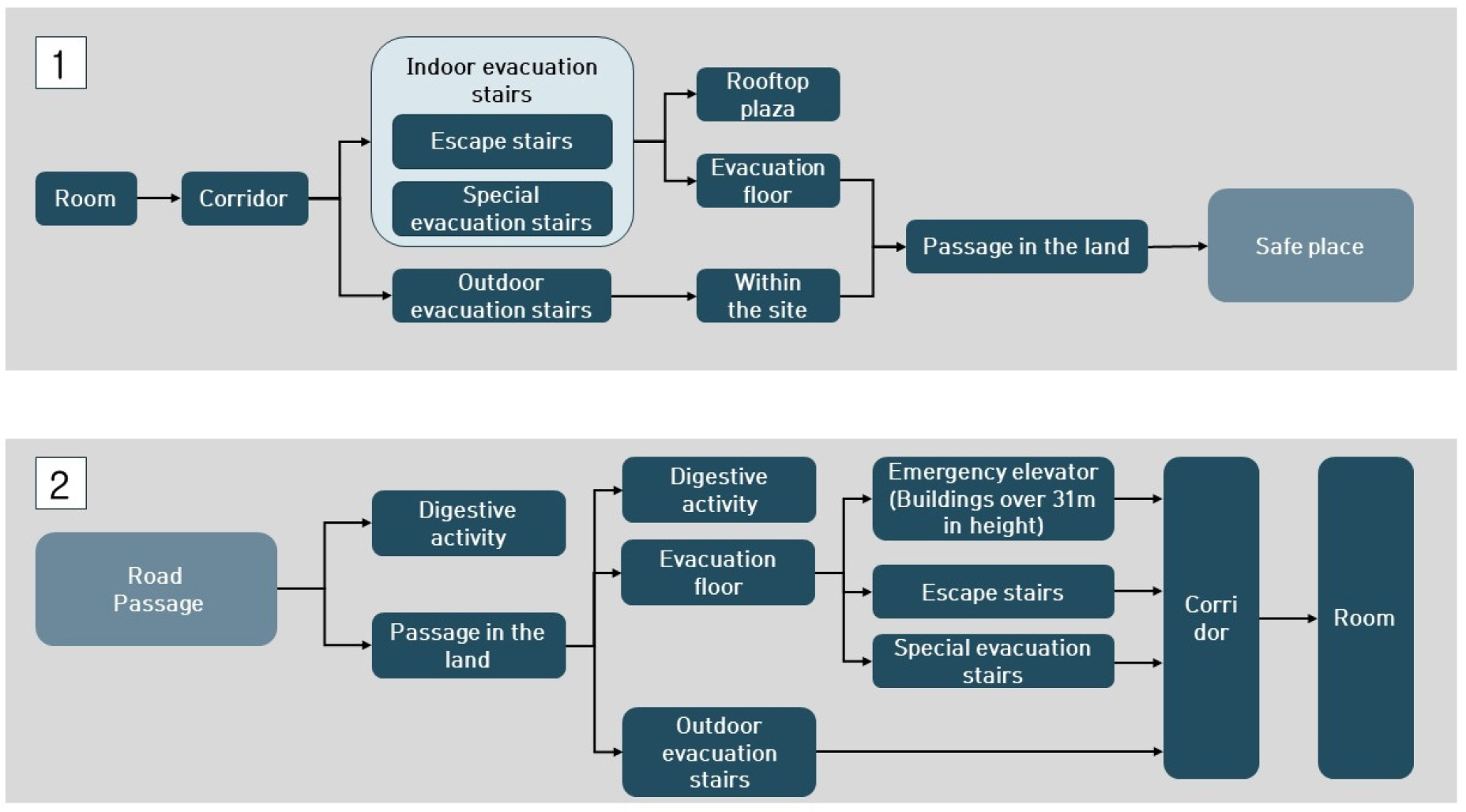1. 서 론
1.1 연구의 배경 및 목적
1.2 연구의 범위 및 방법
2. 국내 도시철도 역 시설에서의 ‘피난’을 위한 제도적 기준 분석
2.1 제도적 범위에서의 ‘피난’의 정의와 관련 규정
2.2 ‘철도역’ 시설의 규정
3. 도시철도역의 역시설의 특성과 ‘피난’ 규정에 대한 제도적 한계
4. 결 론
1. 서 론
1.1 연구의 배경 및 목적
근대 이후 인구집중과 도시의 고밀화로 도시철도는 점차 지상보다 지하공간을 활용하게 되었다. 국내에서는 1899년 철도가 부설되어 개통된 이후 도심 내 철도로서 1974년 지하철 1호선이 서울에 최초 개통되었다. 현재 도시철도는 수도권의 주요 대중교통수단으로 자리 잡고 있으며 또한 이러한 도시 철도역은 서울교통공사 관할 281개 역 중 25개 역을 제외하고 모두 역 시설이 지하에 구축되어 있는 등(2022년 기준, 서울교통공사) 대부분 지하공간을 활용하고 있다.
지하역은 대도시의 토지 활용 측면에서 기존 도시의 조직이나 물리적 밀도에 크게 영향을 미치지 않기 때문에 지속적으로 지하역 건설이 확대되어 왔으나, 지상 공간과는 다르게 위치와 방향을 알기가 어려운 시각적 한계점을 가지고 있으며, 재난 · 재해시 신속한 피난이 어렵다. 더구나 도시철도 지하역 시설은 일반건축물과는 달리 불특정 다수의 사람들이 출근 및 퇴근과 같은 피크 시간대에 반복적으로 이용이 집중될 뿐만 아니라 대중교통 이용 특성과도 맞물려 출입, 대합실, 티켓팅, 플랫폼에 이르는 이용객의 복잡한 동선 체계를 포괄하는 역 시설만의 공간적 특성도 반영되어 있다. 이에 따라 지하공간을 활용한 도시철도의 각 역사 시설에서는 지진, 홍수와 같은 자연재해와 더불어 화재 등의 인재 등 지하공간의 재난재해가 일어날 경우를 대비하여 피난, 소화 및 소방 활동을 위한 재난 시 건축계획적 가이드라인이 필요하다.
본 연구에서는 도시철도 지하역의 ‘피난’ 및 ‘소방’에 관련한 제도적 현황을 살펴보되 건축법 및 소방법 등에서 도시철도역과 같은 불특정 다수의 다중이용시설의 ‘피난’ 및 ‘소방’에 관한 사항과 비교 분석하고자 한다. 이를 바탕으로 현행 도시철도 지하역의 ‘피난’에 관한 사항을 제도적으로 규정하고 있는 철도건축설계지침 및 도시철도건설규칙 등에서의 한계점을 도출하여 이를 바탕으로 가이드라인을 제시하고자 한다.
1.2 연구의 범위 및 방법
연구의 범위는 아래 Table 1과 같이 국내 건축물에서의 ‘피난’ 및 ‘소방’ 관련 건축법 및 소방법 관련 제도와 도시철도건설규칙 및 철도건축설계지침 등 철도시설의 적용에 대한 각 법규 및 지침을 대상으로 하였다. 그리고, 지하에 설치된 도시철도역 시설에 대한 부분으로서 소화설비 등 각종 설비를 제외한 건축구조물에 한정하였다.
Table 1.
Evacuation and firefighting systems in Korea
방법은 국내 건축물에서의 ‘피난’ 및 ‘소방’ 관련 제도와 도시철도건설규칙 및 철도건축설계지침 등 철도시설의 적용에 대한 각 법규 및 지침을 분석하는 한편, 이를 바탕으로 현행 도시철도를 규정하고 있는 제도 내에 마련된 내용의 한계점을 제시하고 개선에 도움을 줄 수 있는 건축계획적 측면의 가이드라인을 제시하고자 하였다.
2. 국내 도시철도 역 시설에서의 ‘피난’을 위한 제도적 기준 분석
2.1 제도적 범위에서의 ‘피난’의 정의와 관련 규정
‘피난’이란 화재, 기타 재해의 위험으로부터 생명의 안전을 지키기 위해 보다 안전한 장소로 이동하기 위한 행위를 말한다. 건축법을 기준으로 살펴보았을 때, 아래 Fig. 1과 같이 (1) 건축물 내에 머무르고 있는 이용객이 건축물 바깥 안전한 장소로 대피하는 과정 중 거치게 되는 각 건축물 내 공간, (2) 외부에서 소방 활동을 하기 위해 재난이 일어난 건축물 내로 진입하는 과정 중 거치게 되는 각 건축물 내 공간을 정의하고 각 공간에 해당하는 규제사항이 마련되어 있다(Building Act, Building Act Enforcement Decree, Building Act Enforcement Rule, 2022).
건축법에서는 이와 관련한 개념 및 각 사항을 다음과 같이 구분하여 정의내리고 있다. 아래의 Table 2에 정리된 바와 같이물리적 공간으로서 ‘피난’과 관련된 규정은 크게 5가지로 분류되었음을 확인할 수 있다.
1) 피난층, 피난안전구역, 대피공간, 방화구획 등 대피하여 머무를 수 있는 공간에 대한 규정
2) 직통계단, 피난계단, 특별피난계단 및 3) 비상용 승강기, 피난용 승강기와 같이 수직이동을 위한 구조물 및 설비에 대한 규정
4) 출입구 등 폐쇄된 시설의 출입문의 형식, 개폐 방식 및 재료, 출입문의 유효폭에 대한 규정
5) 내화구조, 방화구조, 재료와 같이 재난에 보다 안전한 구조물의 형식과 재료에 대한 규정 등이다.
피난층이란 직접 지상으로 통하는 출입구가 있는 층이며, 피난안전구역이란 건축물에서의 피난, 안전을 위하 건축물 중간층에 설치하는 대피공간을 말한다(Building Act, Building Act Enforcement Decree, Building Act Enforcement Rule, 2022). 이 피난층 및 피난안전구역으로 쉽고 안전하게 이동하도록 연계된 규정이 직통·피난·특별피난계단 및 피난용․비상용승강기 규정이다. 지하 2층 이상인 경우 반드시 피난층으로의 직통계단이 설치되어야 하며, 피난계단 및 특별피난계단의 설치는 건축물 내부에서 용도와 목적에 따라 거실 내부로부터 각 계단까지의 보행거리가 규정되어 있다. 여러 사람이 이용하는 다중이용시설물 일수록, 사람들이 머무는 시간이 오랜 주거시설 일수록, 면적과 규모가 크고 이용하는 사람이 많아질수록 계단 및 승강기 설치의 규정이 강화되어 있다. 건축물 바깥쪽, 피난의 방향으로 설치하는 출구의 설치기준도 너비, 개수, 출입구 개폐 형태의 규정이 명시되어 있다(Hwang, 2014).
Table 2.
Types and classification of major regulations related to evacuation and firefighting of buildings (Ref. Ministry of Government Legislation, https://law.go.kr/, 25th Nov. 2022)
2.2 ‘철도역’ 시설의 규정
한편, 어느 법령에서 철도역을 규정하고 있는지를 살펴보면, 해당하는 상위법 및 하위법령체계로부터 철도역의 ‘피난’과 ‘소방’에 관한 규제를 어떻게 적용받는지 확인할 수 있기 때문에 이는 매우 중요하다.
철도역 시설은 상위법부터 살펴보면, ‘국토의 계획 및 이용에 관한 법률 시행령’의 제2조의 기반시설에 속하며, ‘건축법’상 건축물로 정의되어 있지 않다. 건축법상 건축물이란 아래 표와 같이 토지에 정착(定着)하는 공작물 중 지붕과 기둥 또는 벽이 있는 것과 이에 딸린 시설물, 지하나 고가(高架)의 공작물에 설치하는 사무소 등으로서 지하에 설치된 도시철도 역의 경우 ‘건축법’ 상 건축물에 해당하지 아니한다. 따라서 앞서 분석한 건축법의 적용을 받지 아니한다.
아래의 Table 3에서는 지하에 설치된 도시철도역을 규정하고 있는 법령을 나타냈는데, 이들은 ‘도시철도법’, ‘도시철도건설규칙’, ‘철도의 건설 및 철도시설 유지관리에 관한 법률’, ‘지하안전관리에 관한 특별법’, ‘초고층 및 지하연계 복합건축물 재난관리에 관한 특별법’이 있다. 보통 우리가 이해하는 철도역을 각각 역사(驛舍), 정거장(停車場)으로 규정하고 있으며, 그중에서도 지하에 설치된 철도역사를 지하철, 지하역사 등으로 규정하고 있는 것을 확인할 수 있다.
Table 3.
Regulations and definitions of ‘railway station’ facilities in each statute
즉 지하에 설치된 도시철도 역의 경우 기반시설로서 건축법 상 건축에 해당되지 않으며, ‘지하시설물’ 혹은 ‘지하 구조물’로 규정되어 있음에도 불구하고, 철도역 내 이동통로 등에 소매점, 상점, 편의시설 및 기타 소규모 문화공간과 같은 다양한 행위가 일어나는 시설이 함께 복합화 되어 있는 경우가 다수이므로, 건축법 이외에서 이러한 공간의 재난 및 안전관리에 대한 규정이 실질적으로 필요하다.
한편 ’지하안전관리에 관한 특별법’, ‘초고층 및 지하연계 복합건축물 재난관리에 관한 특별법’에서는 대중교통수단으로서 다수의 이용객이 활발하게 이용하는 도시철도 지하역에 한정하지 않고 지하에 마련된 지하상가 및 지하도 시설과 초고층 건축물에 이르기까지를 다루고 있으며, 본 법의 규제를 받는 지하에 설치된 철도역의 경우에도 ‘층수가 11층 이상이거나 1일 수용인원이 5천 명 이상인 건축물로서 지하 부분이 지하역사 또는 지하도상가와 연결된 건축물’로 사실상 도시철도 지하역을 포괄하지 않고 있다는 한계가 있다.
따라서 도시철도 지하역은 건축법 상의 ‘피난’과 ‘안전’에 대한 제도적 규정을 따를 필요가 없으며, 현재 ‘도시철도법’, ‘도시철도건설규칙’, ‘철도의 건설 및 철도시설 유지관리에 관한 법률’ 및 ‘철도건축설계지침’ 등에서 명시된 규정만 적용되고 있다.
3. 도시철도역의 역시설의 특성과 ‘피난’ 규정에 대한 제도적 한계
지하에 설치된 도시철도역은 지하에 위치하고 있다는 점 때문에, 재난상황 발생시 그 피해가 클 수밖에 없다. 특히 최근까지도 국내의 지하공간 규정은 단순히 공간의 면적단위로 피난성능을 규정하고 있다는 한계점(Park et al., 2010, p.60)하에서, 피난 시점으로부터 안전한 구역까지 이동하기까지 피난자의 안전을 보다 확보하기 위해서는 화재감지기, 대피방송, 피난유도등과 같은 소방설비의 설치도 중요하지만, 지하에 환승, 편의시설 이용객, 티켓팅 등 매우 복잡하게 동선이 서로 얽혀 있는 공간구조에 대한 보다 명확한 피난 동선체계가 정리, 규정되어야 한다.
위의 Fig. 2에서 정리된 바와 같이 철도를 이용하기 위해서 반드시 거쳐야 하는 티켓팅 구역은 외부로부터의 출입구로부터 통로, 대합실을 거쳐 열차를 타기 위한 승강장 사이 구간에 반드시 위치하며, 이 구역에서 재난시 빠른 대피가 어려울 수밖에 없는 구조이다. 특히 노선간 환승이 복잡하게 이루어질수록, 지하로의 심도가 깊어질수록 이는 더욱 복잡해진다.
‘도시철도법’, ‘도시철도건설규칙’, ‘철도의 건설 및 철도시설 유지관리에 관한 법률’ 및 ‘철도건축설계지침’에서 규정하고 있는 ‘피난’ 및 ‘소방’ 관련 규정은 아래의 Table 4에서 확인할 수 있다.
첫째, 수도권 도시철도의 경우, 지하철 1호선을 제외하고 각 노선의 평균 심도가 10 m 이상으로 대부분의 지하에 설치된 도시철도역이 일반적인 건축물의 3개층 높이 이하의 깊이, 출입구-대합실 및 티켓팅 구역-승강장이라는 최소 2개층 이하에 위치하고 있다. 하지만 앞서 언급한 각 제도들에서 명시하고 있는 규정들은 주로 ‘열차를 타고 내리는 이용객’을 기준으로 하였으며, 열차 이용을 위해서는 반드시 ‘티켓팅’ 구역을 거쳐야 하기 때문에 이용객의 피난 동선을 고려하기 어려워 열차를 타고내리는 승강장으로부터 지상층(피난층)까지의 직통계단이나 피난, 특별피난계단을 설치할 수 없다는 한계점이 있다.
둘째, 지하공간에 설치된 도시철도역은 1호선이 개통된 이후로 계속 확장되고 있는 바, 여러 노선이 겹치게 될 경우 후에 건설되는 노선이 더 깊은 심도의 지하에 건설될 수 밖에 없고, 철도역이 설치될 해당 지반의 구조, 환승노선의 개수 및 선후 부설 관계에 따라 건축법에서 규정하고 있는 피난층으로의 대피를 위한 보행거리 기준이 충족될 수 없다.
특히 대합실의 경우 여객의 주 동선과 분리되도록 해야 한다는 원칙이 철도건축설계지침에 명시되어 있기 때문에 계단과 승강기 모두 재난 시 승강장으로부터 대합실, 대합실로부터 지상의 출입구까지의 피난 동선은 반드시 대합실에서 1회 멈추어 경유할 수밖에 없는 구조이다.
셋째, 철도건축지침에서는 열차가 정지했을 때, 승강장의 폭 기준이 일률적으로 상대식 4 m 이상 , 섬식 8 m 이상으로 명시되어 있고(Kim, 2016, p.37), 계단의 폭, 너비, 기둥 간 간격에 따른 계단의 위치에 대한 규정이 없어서, 대부분 피난 상황에 대한 고려 없이 각 승강장 내에 설치되어 있다. 이 때, 피크시간대 재난상황 발생시 피난의 흐름에 병목현상이 생길 수밖에 없다(Bae and Park, 2011; Park and Choi, 2022).
Table 4.
Regulations and definitions of ‘railway station’ facilities in each statute
4. 결 론
앞서 도출된 제도적 한계점을 바탕으로 다음과 같은 점이 도출되었다. 국내 ‘도시철도법’, ‘도시철도건설규칙’, ‘철도의 건설 및 철도시설 유지관리에 관한 법률’ 및 ‘철도건축지침’ 등에서 명시하고 있지 않은 각 규정에 대하여 다음과 같이 가이드라인을 제안하고자 한다.
첫째, 지하에 설치된 도시철도역의 경우 불특정 다수의 사람들이 이용하는 대중교통공간으로 물리적으로 지하에 설치된 건축공간의 형태를 띠고 있으나 현행 건축법상 건축물에 속하지 않아 일반적인 건축법상 ‘피난’ 관련 규정을 적용받고 있지 않다. 이에 따라 ‘소방기본법’과 ‘도시철도법’, ‘도시철도건설규칙’, ‘철도의 건설 및 철도시설 유지관리에 관한 법률’ 및 ‘철도건축지침’과 같은 도시철도를 규정하고 있는 철도관련 제도에서 ‘피난’규정을 적용받을 수 밖에 없다. 유사 기준이 개별법령에 분리 제정되어 기준 파악이 어렵고 서로 이원화되어 있기 때문에, 도시철도에 한정하여 도시철도 이용객의 이동 동선에 따라 머무는 공간을 표준화하여 규정할 필요가 있으며 이를 위하여 1) 피난층, 피난안전구역, 대피공간, 방화구획 등 이용객이 대피하여 머무를 수 있는 공간에 대한 규정 2) 직통계단, 피난계단, 특별피난계단 / 비상용 승강기, 피난용 승강기와 같이 수직이동을 위한 구조물 및 설비에 대한 규정 3) 출입구 등 폐쇄된 시설의 출입문의 형식, 개폐 방식 및 재료, 출입문의 유효폭에 대한 규정 4) 내화구조, 방화구조, 재료와 같이 재난에 보다 안전한 구조물의 형식과 재료에 대한 규정 등앞서 제시했던 4개 사항에 대한 규정이 구체적이고 체계화되어 구분되어 명시될 필요가 있다. 또한 현재 여러 제도에 규정되고 있으므로 이를 통합하여 일원화하되 ‘도시철도건설규칙’, ‘철도건축지침’과 같은 하위법보다는 상위법인 ‘철도의 건설 및 철도시설 유지관리에 관한 법률’에 이를 규정할 필요가 있음을 제안하고자 한다.
둘째, 일반 건축물과 달리 도시철도의 경우, 지하철 1호선을 제외하고 각 노선의 평균 심도가 10 m 이상으로 대부분의 지하에 설치된 도시철도역이 일반적인 건축물의 3개층 높이와 유사한 길이의 깊이에 위치하고 있다. 하지만 이들 법에서 명시하고 있는 규정들은 주로 ‘열차를 타고 내리는 이용객’을 기준으로 ‘열차 내에서의 재난상황’에 초점을 맞추었다. 그러나 실제로 물리적으로 건축구조물인 철도역의 이용행태가 열차이용을 위해서는 반드시 ‘티켓팅’ 구역을 거쳐야 하기 때문에 이에 적합한 이용객의 피난 동선을 고려해야만 한다. ‘티켓팅’이라는 절차의 특수성을 볼 때, 티켓팅과 승강장 사이에 피난안전구역, 방화구획 등에 대한 구체적인 명시가 필요할 수 있다.
셋째, 건축법에서 명시된 비상용 승강기의 설치기준이 높이 31 m를 넘는 건축물, 피난안전구역 및 대피시설의 설치기준이 최대 30개 층마다 1개층으로 설치해야 하는 기준을 고려하면, 지하 30 m이상 깊이의 대심도에서 승강장이 있는 경우, 유사한 기준에 따라 피난층을 설치하도록 할 필요가 있다.
한편, 본 연구에서는 피난 및 소방에 대한 현행 제도적 한계점을 살펴보았으나, 건축적 측면에서의 제도적 한계점만을 분석하였다는 데 한계가 있다. 지하에 설치된 복잡한 공간구조인 도시철도 지하역에서, 보다 효율적인 피난 구조, 재난시 신속하고 안전한 대피를 위한 각 조건 확보, 안전 체계의 적절한 작동을 위해서는 건축적 측면뿐 아니라 소방설비에 대한 기준도 적합하도록 현행기준에서 보완되어야 한다. 따라서 추후 현행 도시철도에 적용되고 있는 소방설비 및 시설의 설치기준에 대한 한계점 분석이 먼저 필요하며 이를 바탕으로 가이드라인 제시의 기초가 될 수 있다.






